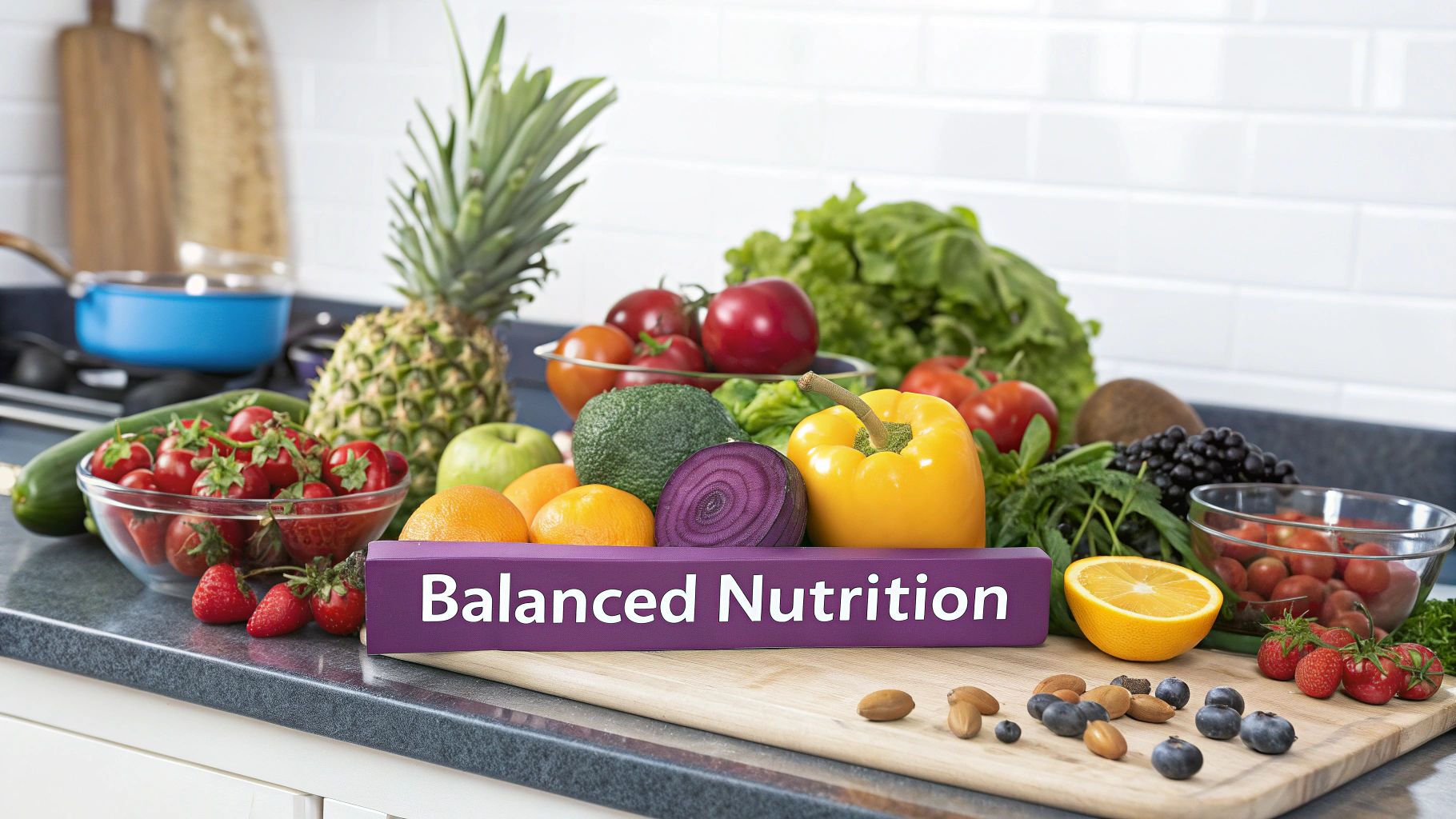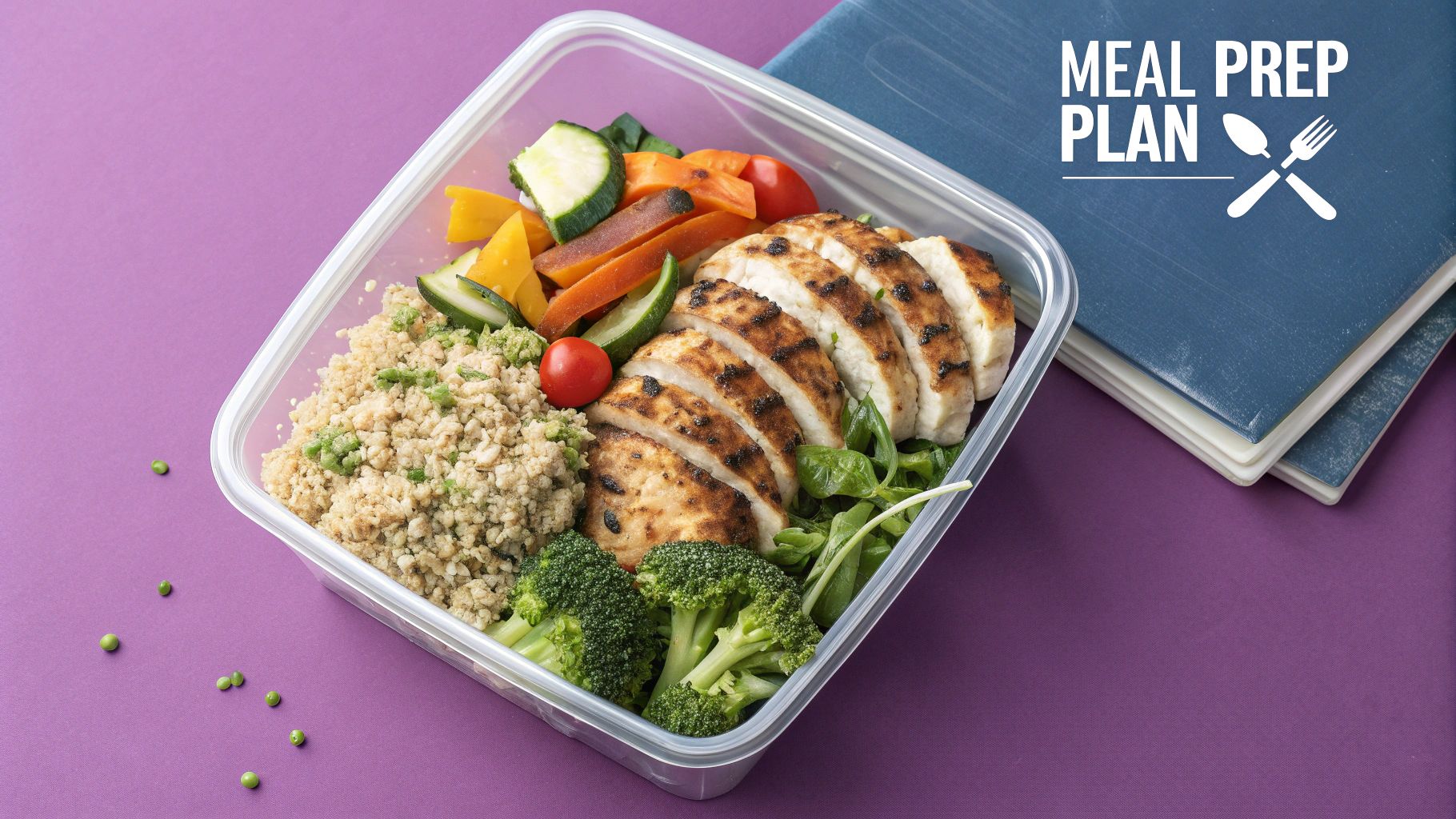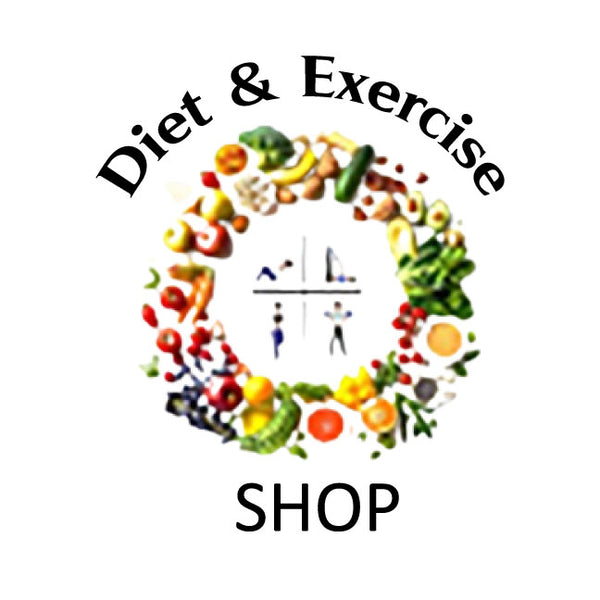
The Ultimate Healthy Eating and Workout Plan That Actually Works
A good fitness plan isn't about flipping your life upside down overnight. The real secret to success is building a solid foundation based on clear, personal goals and habits you can actually stick with.
It all begins with getting honest about where you are right now. This allows you to set realistic expectations for where you want to go, whether that's losing weight, building muscle, or just feeling more energetic.
Laying the Groundwork for Lasting Success
Jumping into a new health and fitness routine can feel like a huge undertaking. But the key isn't a complicated, restrictive system. It’s about thoughtful preparation, both mentally and practically.
Think of this first phase as creating your personal roadmap. This guide ensures your efforts in the kitchen and the gym pull in the same direction, saving you from burnout and frustration.
This process kicks off with a simple self-assessment. Before you can figure out how to get to your destination, you have to know your starting point. This isn't about judging yourself; it’s about gathering data.
Jot down your typical meals, how much you move each day, and how your energy levels change. This baseline is what you’ll use to measure how far you’ve come later on.
Define Your "Why" and Set Clear Goals
Your motivation is the engine that will keep you going when things get tough. So, ask yourself: why do I really want to do this?
Is it to lose a few pounds? To build strength? Or maybe you just want more energy to keep up with your kids.
Get specific. A vague goal like "get in shape" is easy to abandon. A better approach is, "I want to lose 10 pounds in 3 months by walking for 30 minutes, four times a week, and packing my lunch." Now that's a target you can work with.
The most powerful goals are the ones tied to what truly matters to you. When you connect your fitness journey to your core values, it stops feeling like a chore and starts feeling like a part of who you are.
Following a structured, health-focused plan is becoming more common. A recent study found that 54% of American adults follow a specific diet or eating pattern. This shows people want plans that support long-term health. You can discover more insights about these food trends and see how consumer choices are evolving.
Combining Diet and Exercise from Day One
One of the biggest mistakes people make is focusing only on diet or exercise, but not both at the same time. Real, lasting change happens when they work together.
The food you eat fuels your workouts and helps your body recover. Exercise fires up your metabolism and helps sculpt your physique.
Here’s a quick look at how you can align them based on your goals:
- For Weight Loss: Create a small calorie deficit through your diet. Pair that with workouts that burn calories and build muscle, like brisk walking and basic strength training. A great first step is swapping one processed snack for a piece of fruit each day.
- For Muscle Gain: You’ll need a slight calorie surplus with enough protein to help your muscles grow. In the gym, focus on progressive resistance training—gradually lifting heavier over time.
- For General Health: Aim for a balanced diet of whole foods. Combine that with consistent physical activity you enjoy, like dancing, hiking, or swimming.
Quick Start Fitness Goal Framework
| Fitness Goal | Primary Focus (Diet) | Primary Focus (Workout) | Key Starting Habit |
|---|---|---|---|
| Weight Loss | Modest calorie deficit | Cardio + Strength Training | Track food intake for 3 days to build awareness. |
| Muscle Gain | Calorie surplus, high protein | Progressive Resistance Training | Add 1 protein source to every meal. |
| Improved Energy | Whole foods, balanced macros | Consistent, enjoyable activity | Go for a 15-minute walk after lunch each day. |
| Better Endurance | Complex carbs for fuel | Cardiovascular exercise | Start with 2 cardio sessions per week (20-30 min). |
Nailing down this initial framework makes everything that comes next feel more manageable. Your plan will start to feel like a natural part of your life.
Crafting a Nutrition Plan You'll Actually Enjoy
Let's be honest: a perfect nutrition plan is worthless if you hate the food. The secret to a healthy eating and workout plan that sticks isn't about restriction. It's about finding a way to eat that leaves you feeling energized, satisfied, and happy.
Think of food as high-quality fuel for your body. It's what powers you through workouts and helps you recover stronger.

We need to ditch the "good food" vs. "bad food" mentality. The focus should be on building balanced, nutrient-dense meals you look forward to eating.
Understanding Your Fuel: Macronutrients
Everything you eat is a mix of three macronutrients: protein, carbohydrates, and fats. Each has a critical job, especially when you’re active.
-
Protein: Protein is your body's repair crew. It provides amino acids to patch up muscles after a workout, making them stronger. It’s also very filling. Find it in chicken, fish, eggs, and beans.
-
Carbohydrates: Carbs are pure energy. Prioritize complex carbs like oats and sweet potatoes for a slow, steady stream of fuel.
-
Fats: Healthy fats are essential for hormones and vitamin absorption. Good choices include avocado, nuts, seeds, and olive oil.
The ideal macro ratio depends on your goal. Someone building muscle needs more protein. An endurance athlete needs more carbs. A good starting point is to include a source of each in every meal.
The Power of Post-Workout Nutrition
What you eat after a workout is crucial. For about 30-45 minutes post-exercise, your muscles are primed to soak up nutrients for repair. This is the "anabolic window."
Missing this window is a missed opportunity. A protein smoothie is a perfect, quick solution.
Having the right gear helps. The Performance Protein Shaker from dietexerciseshop.com makes refueling easy. It's durable, leak-proof, and ready when you are. Just add water, shake, and you’re fueling your recovery in seconds. Timely refueling is non-negotiable for real results.
Delicious and Simple Meal Ideas
Healthy food is not boring food. Here are a few simple, delicious meal ideas built around whole foods to support your active lifestyle.
Sample Meal Plan
| Meal | Idea | Key Nutrients |
|---|---|---|
| Breakfast | Oatmeal with berries, a spoonful of almond butter, and a sprinkle of chia seeds. | Complex carbs, healthy fats, fiber, and protein. |
| Lunch | Big salad with grilled chicken, mixed greens, chickpeas, and a light vinaigrette. | Lean protein, fiber, and essential vitamins. |
| Dinner | Baked salmon with roasted sweet potatoes and steamed broccoli. | Omega-3s, protein, and complex carbs. |
| Snack | Greek yogurt with a small handful of walnuts. | Protein and healthy fats. |
Building meals around whole foods creates a nutrition plan that gets you closer to your goals and tastes great. For more tips, check out the Diet & Exercise YouTube channel.
Designing a Workout Routine That Actually Fits Your Life
The best workout plan isn't from a celebrity. It's the one you'll actually stick with.
Effective exercise is about building strength for daily life, boosting your mood, and feeling capable. A good plan should feel sustainable, not like a chore.

The trick is to weave three pillars of fitness into your week: cardio, strength training, and flexibility work. A good balance improves your health from every angle.
The Three Pillars of a Balanced Fitness Plan
To avoid plateaus and injuries, variety is key. Make sure your week includes these three core components.
-
Cardiovascular Exercise: This gets your heart rate up. Think brisk walking, running, or cycling. Cardio is essential for heart health and energy.
-
Strength Training: This uses resistance to build muscle. Functional strength helps with daily tasks like carrying groceries and maintaining good posture.
-
Flexibility and Mobility: This is often skipped but is a game-changer. Stretching, yoga, or foam rolling helps prevent injuries and eases muscle soreness.
Building Your Workout Schedule
Consistency is the goal, not perfection. If you're new, three workout days a week is a great start. A more seasoned person might aim for five.
Here are a couple of examples.
Beginner Sample Schedule (3 Days/Week)
| Day | Workout Focus (30-45 minutes) | Example Activities |
|---|---|---|
| Day 1 | Full Body Strength | Bodyweight squats, push-ups (from your knees is perfect!), planks, lunges. |
| Day 2 | Cardio & Flexibility | A 20-30 minute brisk walk or jog, followed by 10 minutes of stretching. |
| Day 3 | Full Body Strength | Do Day 1 again! Try to improve your form or maybe add an extra rep or two. |
This simple approach gives your body time to recover. You can find visual guides on our Diet & Exercise YouTube channel, where we break down proper form for key exercises.
Making Home Workouts Count
You don't need a gym to get in fantastic shape. A successful home workout routine just needs a few versatile tools.
The most effective workout is the one you actually do. By removing barriers like travel time to a gym and creating an effective space at home, you dramatically increase your chances of staying consistent.
One of the best investments for a home gym is an adjustable dumbbell set. Instead of a whole rack of weights, a single set can grow with you.
The Adjustable Dumbbell Set from dietexerciseshop.com is a perfect example. You can switch the weight in seconds, making it ideal for everything from light shoulder raises to heavy squats. This kind of versatility is the cornerstone of any serious at-home healthy eating and workout plan.
For more guidance, our guide on workout routines for beginners at home is packed with detailed plans and tips.
Matching Your Diet and Exercise to Your Goals
The secret to results is making diet and exercise work together. Think of them as two gears in a machine. When they’re aligned, you create powerful momentum.
Whether you're building muscle or losing weight, your nutrition must support your physical effort. This is what separates a plateau from real progress.
Fueling for Lean Muscle Growth
To build lean muscle, protein is your best friend. When you lift weights, you create tiny tears in muscle fibers. Protein provides the building blocks to repair that damage and build muscle back stronger.
Anchor every meal with high-quality protein like chicken, lean beef, fish, or eggs.
Of course, you also need a progressive strength training program. Consistently challenge yourself by lifting heavier or doing more reps. This gives the protein a job to do.
For a detailed breakdown, learn how to calculate your macros for muscle gain with our in-depth guide.
Optimizing for Fat Loss
For fat loss, your diet’s main job is creating a manageable calorie deficit. This means consuming slightly less energy than your body uses, encouraging it to burn stored body fat.
Focus on nutrient-dense foods like leafy greens, veggies, and lean proteins to stay full.
On the workout side, your goal is to burn calories and fire up your metabolism. High-Intensity Interval Training (HIIT) is perfect for this. These workouts involve short, intense bursts of effort followed by quick recovery periods.
This infographic breaks down how different exercises stack up.

While long cardio burns calories in the moment, strength training builds muscle that helps you burn more calories around the clock.
Combining a calorie-conscious diet with the metabolic kick from HIIT is the ultimate one-two punch for fat loss. It's about being strategic with your food and intentional with your movement.
Fitness Goal Diet and Workout Synergy
| Primary Goal | Recommended Diet Style | Recommended Workout Type | Recommended Product |
|---|---|---|---|
| Muscle Gain | High-protein, slight calorie surplus | Progressive strength training, 3-5 days/week | Performance Protein Shaker |
| Fat Loss | Moderate calorie deficit, high-fiber | HIIT and full-body strength training | Smart Body Fat Scale |
| Endurance | Carb-focused for fuel | Long-distance cardio, interval running | Performance Protein Shaker for hydration |
| Overall Health | Balanced, whole foods diet | Mix of cardio, strength, and flexibility | Adjustable Dumbbell Set |
This table shows how your diet, workouts, and gear should all point toward your specific goal.
Staying Consistent and Measuring What Matters
You’ve created a plan. That's a huge win. But the real magic happens in the day-to-day consistency.
Perfection isn't the goal; persistence is. You'll have off days. The key is having strategies to keep moving forward and measuring what actually matters.

Go Beyond the Scale for Real Progress
Staring at the scale every day can kill your motivation. Body weight fluctuates based on water, hormones, or what you ate. It’s a tiny piece of the puzzle.
To truly understand your progress, look at other signs.
The scale only measures your relationship with gravity. It says nothing about your strength, endurance, or how your clothes fit.
Here are better ways to track your progress:
- Take Progress Photos: Every four weeks, snap photos. Comparing them can be a powerful reminder of how much your body is changing.
- Notice How Your Clothes Fit: Is that favorite pair of jeans feeling looser? These are real-world signs your hard work is paying off.
- Track Your Performance: Are you lifting heavier? Can you run for an extra five minutes? These performance gains are concrete proof you're getting fitter.
Using Technology to Your Advantage
Modern tools can offer incredible insights. A smart scale is a game-changer for your healthy eating and workout plan. It goes beyond pounds, giving you a detailed look at your body composition.
The Smart Body Fat Scale from dietexerciseshop.com is a fantastic tool. It syncs to a phone app, tracking key metrics over time.
This single device can tell you about:
- Body Fat Percentage: Are you losing fat while keeping muscle?
- Muscle Mass: Is your strength training building muscle?
- Body Water: How do hydration levels affect your weight?
- Bone Mass: Get a more complete picture of your health.
Seeing muscle mass go up while body fat drops—even if the scale barely moves—is a massive victory. That kind of feedback shows the plan is working.
Overcoming Plateaus and Staying Motivated
Sooner or later, everyone hits a wall. Progress stalls. It’s a normal part of the process.
A plateau is your body’s signal that it has adapted. It’s time to shake things up.
If you find yourself stuck, try one of these:
- Introduce Variety: Been doing the same routine? Try a new fitness class or learn new exercises. For fresh ideas, check out the videos on the Diet & Exercise YouTube channel.
- Adjust Your Nutrition: Take an honest look at your eating habits. Have extra portions crept back in? Small tweaks can get things moving again.
- Prioritize Rest: More isn't always better. Overtraining can sabotage progress. Get quality sleep and take rest days.
One "bad" meal or skipped workout doesn't ruin everything. Just get back on track with your next healthy choice.
Common Questions About Diet and Exercise Plans
Kicking off a new health plan comes with questions. Getting straight answers can be the difference between sticking with it and giving up. Let's tackle some common ones.
How Long Until I See Results from My New Plan?
Everyone's body is different, but you'll likely feel changes before you see them. Most people report more energy and better sleep within 2 to 4 weeks.
For visible results—like clothes fitting better—give it 8 to 12 weeks of consistent effort. Progress isn't just a number; it's about how you feel day-to-day.
For Weight Loss Is Diet or Exercise More Important?
Both are critical, but they have different jobs. Your diet is the heavy lifter for initial weight loss. It’s easier to create a calorie deficit by changing food choices than by burning off calories in the gym.
But exercise keeps your metabolism fired up, builds strength, and boosts mental health.
Think of it this way: Diet is what reveals your progress, but exercise is what builds a stronger body and makes the results last.
A truly effective healthy eating and workout plan treats them as partners.
How Can I Stick to a Plan with a Busy Schedule?
A packed schedule is a common roadblock. Treat your workouts like important meetings—block them off in your calendar. Even a quick 20-minute session is better than nothing.
For food, meal prep is your secret weapon. Spend an hour on Sunday getting things ready.
- Grill up a batch of chicken or bake some tofu.
- Chop veggies for easy salads and stir-fries.
- Portion out snacks like almonds or Greek yogurt.
When healthy food is the easy option, you’re more likely to stick to your plan.
Are Supplements Necessary for Good Results?
No. Supplements are just that—supplemental. Your foundation should always be whole, nutrient-rich foods.
That said, they can be convenient. A protein powder can help muscle recovery when you're in a rush. For ideas on post-workout shakes, the Diet & Exercise YouTube channel has easy-to-follow videos. Just talk with a doctor before starting anything new.
At Diet and Exercise, we’re here to support your journey with gear that helps you feel comfortable and confident. From your very first workout to your next big personal best, we've got you covered. Check out the full collection and find your new go-to apparel at https://dietexerciseshop.com.
